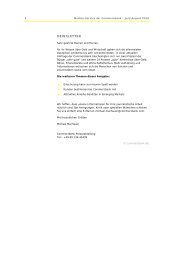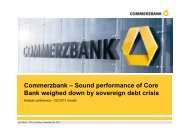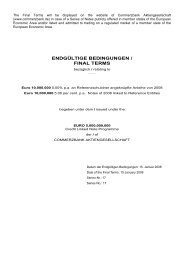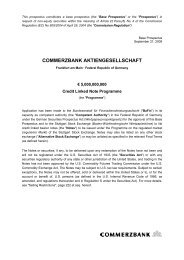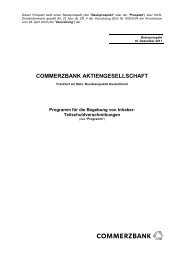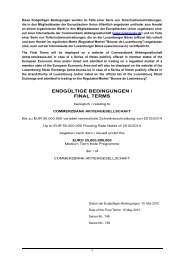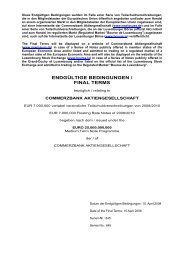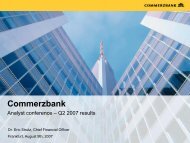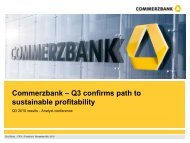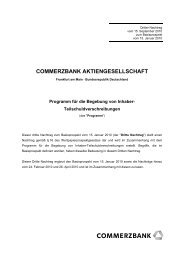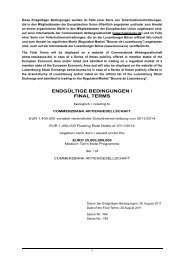COMMERZBANK AKTIENGESELLSCHAFT
COMMERZBANK AKTIENGESELLSCHAFT
COMMERZBANK AKTIENGESELLSCHAFT
You also want an ePaper? Increase the reach of your titles
YUMPU automatically turns print PDFs into web optimized ePapers that Google loves.
Group Financial Statements<br />
276<br />
220 Commerzbank Annual Report 2011<br />
Such a separation must be made if the following three<br />
conditions are met:<br />
• the economic characteristics and risks of the embedded<br />
derivative are not closely related to those of the host contract;<br />
• a separate instrument with the same terms as the embedded<br />
derivative would meet the definition of a derivative under<br />
IAS 39; and<br />
• the hybrid (combined) contract is not measured at fair value<br />
through profit or loss.<br />
In this case, the separately shown embedded derivative is<br />
regarded as part of the trading portfolio and recognised at fair<br />
value. Changes on remeasurement are recognised in profit or<br />
loss under net trading income. The host contract is accounted<br />
for and measured applying the rules of the category to which the<br />
financial instrument is assigned.<br />
If the above three conditions are not met, the embedded<br />
derivative is not shown separately and the hybrid financial<br />
instrument or structured product is measured as a whole in<br />
accordance with the general provisions of the category to which<br />
the financial instrument is assigned.<br />
f) Hedge accounting<br />
IAS 39 contains extensive hedge accounting regulations which<br />
apply if it can be shown that the hedging instruments –<br />
especially derivatives – are employed to hedge risks in the<br />
underlying non-trading transactions.<br />
Two main types of hedge accounting are used:<br />
• Fair value hedge accounting:<br />
IAS 39 prescribes the use of hedge accounting for derivatives<br />
which serve to hedge the fair value of assets or liabilities<br />
against one or more defined risks. It is above all the Group’s<br />
issuing and lending business and its securities holdings for<br />
liquidity management, where these consist of fixed-income<br />
securities, that are subject to interest rate risk. Interest rate<br />
swaps are primarily used to hedge these risks.<br />
In line with the regulations for fair value hedge<br />
accounting, the derivative financial instruments used for<br />
hedging purposes are recognised at fair value as fair values<br />
of derivative hedging instruments. Any changes in the fair<br />
value of the hedged asset or hedged liability resulting from<br />
an opposite move in the hedged risk are also recognised in<br />
profit or loss under net income from hedge accounting. Any<br />
portion of the changes in fair value that are not attributable to<br />
the hedged risk are accounted for in accordance with the<br />
rules of the valuation category to which the hedged asset or<br />
liability belongs. For interest rate risks fair value hedge<br />
accounting can take the form of either a micro fair value<br />
hedge or a portfolio fair value hedge.<br />
– In micro fair value hedge accounting an underlying<br />
transaction is linked with one or more hedging<br />
transactions in a hedging relationship. The carrying<br />
amounts of the hedged transactions are adjusted through<br />
profit or loss in the event of changes in fair value<br />
attributable to the hedged risk.<br />
– In a portfolio fair value hedge interest rate risks are<br />
hedged at the portfolio level. It is not individual transactions<br />
or groups of transactions with a similar risk<br />
structure that are hedged, but instead a portfolio of<br />
underlying transactions is created grouped by maturity<br />
bands in accordance with the expected repayment and<br />
interest adjustment dates. Portfolios may contain only<br />
assets, only liabilities, or a mixture of both. In this type of<br />
hedge accounting, changes in the fair value of the<br />
underlying transactions are reported in the balance sheet<br />
as a separate asset or liability item. The hedged amount of<br />
the underlying transactions is computed in the<br />
consolidated financial statements excluding demand or<br />
savings deposits (we have thus elected not to use the EU<br />
carve-out regulations).<br />
• Cash Flow Hedge Accounting:<br />
IAS 39 prescribes the use of cash flow hedge accounting for<br />
derivatives which serve to hedge the risk of a change in<br />
future cash flows. Derivatives used in cash flow hedge<br />
accounting are measured at fair value. The effective portion<br />
of gains and losses are recognised net of deferred taxes in<br />
the cash flow hedge reserve under equity. The ineffective<br />
portion, on the other hand, is reported in profit or loss in net<br />
income from hedge accounting. The general accounting rules<br />
set out above for the underlying transactions of the hedged<br />
cash flows remain unchanged by this.



